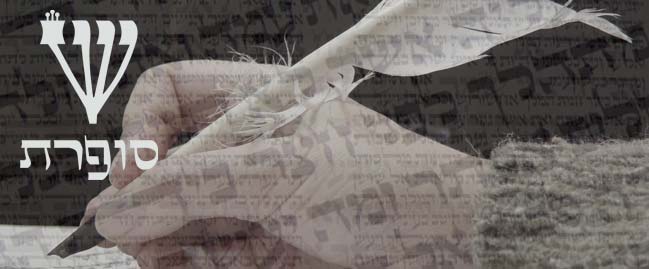CURIOUSER AND CURIOUSER...
BS"D
WOMEN AND THE MITZVAH OF WRITING A SEFER TORAH, chapter 4 p 42-49
"The Rambam rules that "every single Jewish male" has a Biblical mitzvah to write a Sefer Torah (Laws of Sefer Torah, chap. 7, law 1). The obvious inference is that women are excluded from the mitzvah. Indeed, the Rambam leaves no possible doubt as to his intention by specifically recording in the Sefer HaMitzvot that mitzvah 18 (the mitzvah of writing a Sefer Torah) is not applicable to women (Sefer HaMitzvot, conclusion of section on positive commandments).
Yet no reason is presented for the exclusion of women from the mitzvah. Writing and possessing a Sefer Torah is not comparable to, for example, the mitzvah of tefillin, which is not observed on Shabbat, holidays, or at night. Women are exempt from tefillin because they are not required to perform mitzvot which must be observed only within a specific time reference. The mitzvah of writing a Sefer Torah, however, has no time dimension. It may be observed at any and all times. If so, why are women excluded from the mitzvah?
The Shagot Aryeh (responsum 35) outlines three possible reasons for the exclusion of women and then challenges the validity of each of them.
1. Rabbenu Asher ruled that learning Torah is the purpose of the mitzvah of
writing a Sefer Torah. Since women are exempt from the mitzvah of learning
Torah, there is no reason to obligate them to write a Sefer Torah.
2. Women are exempt from performing many of the mitzvot. Since the Sefer Torah
includes all of the mitzvot, they should not be obligated to write a Sefer
Torah. (In other words, why require them to write something that they are
not commanded to observe?)
3. A woman may not serve as a scribe to write a Sefer Torah. Since women cannot
perform the writing process, they should be excluded from the mitzvah.
The Shagot Aryeh refutes each of these points with the following arguments:
1. Women are required to learn the mitzvot applicable to them. Indeed, it has
been Halachically decided that they may voluntarily assume the obligation to
chant the Birchat HaTorah. As a result, they certainly are involved in the
mitzvah of learning Torah and should be mandated to write a Sefer Torah.
2. The logical extension of the reasoning that women are exempt from writing a
Sefer Torah because they are not required to perform certain mitzvot would
also exempt most Jewish men from the mitzvah. Many mitzvot are only
applicable to kohanim or to a kohen gadol. Some mitzvot relate only to
kings. Are non-kohanim exempt from writing a Sefer Torah simply because it
contains mitzvot that they are not commanded to observe?
3. Although women may not write mezuzot, they are required to have mezuzot on
their doorposts. Just as exemption from the writing process does not exclude
them from the mitzvah of mezuzot, it should not exclude them in the case of a
Sefer Torah.
On the basis of the preceding analysis, the Shagot Aryeh concludes that there is no logical foundation for the Rambam's exemption of women from the mitzvah.
R. Yosef Dov Ber Soloveitchik (Responsa Beit Halevi, no. 6) suggests that women are excluded from the mitzvah simply because they are not obligated to learn Torah. The fact that women need to learn the mitzvot applicable to them does not place them in the same category as men. Indeed, there is a major qualitative distinction differentiating the role of women and men in Torah study.
Men are mandated to learn even the mitzvot that they are not required to observe. This means that a man who is not a kohen, and therefore not obligated to observe the laws pertaining to kohanim, is still required to learn the Torah and mitzvot of kohanim. Torah learning is all-inclusive and prevails even in instances where observances are not required. Men are mandated to learn all of the mitzvot of the Torah. Women, however, have no obligation to learn those mitzvot which are not applicable for practical observance. As a result, their scope of Torah learning is quite limited. Since the purpose of the mitzvah of writing a Sefer Torah is not the observance of mitzvot but the learning of Torah, women, with their limited obligations, are exempt from the mitzvah. Men, however, are directly involved in all mitzvot - because of their mandate to learn all facets of Torah.
The Beit Halevi in his commentary on the Pentateuch (Parshat Mishpatim) delineates a further fine distinction between the obligations of men and women in the sphere of Torah study. He notes that Torah education has a twofold aim: the pursuit of Torah knowledge as a means to better observance of commandments and as an end in itself.
An elaboration of this distinction is as follows: To be a good Jew - to carefully and scrupulously follow the dictates of our religion - it is necessary to be well acquainted with many of its laws and customs. Indeed, it is written that an ignoramus cannot be a pious person. This is quite understandable, for a person who is ignorant of Judaism certainly cannot know whether he is doing something right or wrong. It is, moreover, practically impossible to observe the Shabbat if one is ignorant of the intricate, detailed laws of this holy day. Thus, Torah study serves as the vehicle to stimulate the observance of mitzvot. Women are involved in this facet of Torah study.
Yet there is another important aspect to the study of Torah - the obligation to study Torah for its own sake. This aspect of Torah education is not a means of observing commandments but a mitzvah in itself. Just as kashrut and putting on tefillin are commandments, so too is the study of Torah. This obligation is incumbent upon all Jewish men, including those who consider themselves grand masters in all aspects of the Law. Even a person who feels that he knows the entire Torah is still obligated to learn Torah. The Talmud portrays this concept when it relates that a tanna asked whether someone who was well versed in all aspects of the Torah was free from the obligation to study it. The answer presented was that if one could find a period of time which was neither a part of the day nor a portion of the night, only then would he be absolved of all requirements to learn Torah (Menachot 99b).
It is interesting to note that there is a great practical difference between the two approaches to the study of Torah. If Torah study weren't simply a means of acquiring the technical knowledge necessary for an observant Jew, then it would, perhaps, be possible to free oneself from the obligation to learn by retaining the services of a scholar who could outline everything one needed to know. However, since men must study Torah for its own sake, doing this would not be valid. Just as the rabbi's act of putting on tefillin or observing Shabbat does not in any way free others from these mitzvot, so too the rabbi's intense scholarship does not in any way affect the requirement of others to spend a portion of their time learning Torah. Thus the role of men in the mitzvah of Torah study is categorically different from the role of women. Women are merely involved in Torah laws applicable for their own observance. They are concerned with the end product of practical, applied Torah, but men are involved in the process of learning Torah for its own sake.
This extension of the Beit Halevi's theory may be utilized as an additional rationale for exempting women from the mitzvah of writing a Sefer Torah. According to Rabbenu Asher, the purpose of the mitzvah is to learn Torah. Women may be involved in learning practical Torah concepts but have no mitzvah to continue learning those ideas that they already have mastered for the observance of mitzvot. Thus, even [in] regard to specific mitzvot that women are required to observe, such as kashrut or Shabbat, they are not charged with a mitzvah to engage in the profundities of the concepts. In other words, Torah study per se is not within their mandated scope. Thus, they are limited even in regard to the mitzvot that are applicable to them. Since the purpose of the mitzvah is the process of learning Torah, however, it is understandable why they are exempt.
There is a third solution to the problem of why women were excluded from the mitzvah of writing and possessing a Sefer Torah.
Rabbenu Asher notes that the purpose of the mitzvah of having a Sefer Torah is to learn Torah. In other words, the Sefer Torah is to be used as a text to facilitate Torah study. Yet a careful reading of the Biblical mandate suggests a nuance generally not noted by the commentaries. The Bible at no time states that the purpose is to learn Torah. The Scripture, rather, says: "and teach it to the Children of Israel" (Deuteronomy 31:19). Indeed, the Bible says that when Moshe Rabbenu completed the Torah, "he taught it to the Children of Israel" (Deuteronomy 31:22). Thus, the purpose of the mitzvah is not to learn Torah but to teach Torah. The Sefer Torah was to be a text that would facilitate the teaching of Torah to Kelal Yisrael. The Talmud (Kiddushin 29b) specifically states that women are exempt from the mitzvah of teaching Torah. As a result, it is clear why women are exempt from the mitzvah of writing a Sefer Torah. The Sefer Torah was to be an aid in teaching Torah, and since women are not involved in this facet of Torah study, they are not mandated to write a Sefer Torah.
This formulation provides a clear distinction between the purposes of the royal Sefer Torah required of a king and the Sefer Torah mandated for the ordinary Jew. The latter may have been for teaching Torah, while the former was for learning Torah.
Somewhat of a source for this theory is the following Halachah. The Shulchan Aruch (Orach Chayyim 150:1) rules that members of a community may be coerced to acquire a Sefer Torah, Nevi'im, and Ketuvim. The Magen Avraham (ibid.) notes that in our day there is also an obligation for a community to obtain a Talmud. The Ba'er Heitev (ibid.) reports this latter Halachah and contends that the reason is that the Talmud would facilitate anyone who wishes to learn Torah. Yet a close reading of the Magen Avraham reveals quite a different orientation. The Magen Avraham does not state that the purpose of the acquisition of a Talmud is to learn Torah or to facilitate such learning. Regarding the requirement to obtain Ketuvim the Magen Avraham notes that the purpose was so that anyone who desired might learn therein, yet of the suggestion to acquire a Talmud, the Magen Avraham says: Lelamed bahem leketanim ulegedolim, which literally means, "To teach with them to children and to adults." In other words, the purpose of the Talmud was not to learn Torah but to teach Torah. Indeed, the Mishnah Berurah (ibid.) quotes the exact terminology of the Magen Avraham.
Perhaps the theory presented is the basis for such a ruling. The mitzvah of writing a Sefer Torah was for the purpose of providing a tool for the teaching of Torah. As religious texts took the place of Sifrei Torah, they too were to be utilized for purposes of teaching rather than learning Torah.
This position also generates new insights into the basic formulation of the mitzvah.
Moshe is traditionally referred to as Rabbenu - "our Rebbe" - our teacher. This suggests that his foremost role as a leader was that as a teacher of Torah. It is for this reason, perhaps, that he instituted Keri'at HaTorah (Rambam, op. cit.). It was a vehicle to perpetuate his role after his death. No longer would Kelal Yisrael need to depend upon one man. Every community would have an opportunity to manifest public Torah study. But was it not sufficient to ritualize a Torah study session during prayers? The necessity of using a Sefer Torah suggests that a Sefer Torah plays a unique role in Torah study.
The Talmud (Sotah 37a) contends that for each mitzvah there were four covenants relating to the following four integral aspects of mitzvot: to learn (lilmod), to teach (lelamed), to guard (lishmor), and to observe (la'asot). Commentating on this citation, the Brisker Rav (R. Yitzchak Ze'ev Soloveitchik, Bible - Parshat Devorim) notes that the third aspect requires definition. What, he asks, is the distinction between guarding Torah and observing Torah? Since the latter clause relates to both positive and negative commandments, guarding Torah must have a specific application. The Brisker Rav suggests that the commitment "to guard Torah" (lishmor) refers to the need to preserve the purity of the Mesorah. It is, Therefore, an obligation not only to learn Torah and observe Torah and mitzvot but also to sustain the purity of the transmission of Torah.
This then may be the key to the establishment of Keri'at HaTorah and an additional reason for the mitzvah of writing a Sefer Torah. The Midrash notes that Moshe Rabbenu wrote thirteen Sifrei Torah on the day of his death. Each of the twelve tribes was given a Sefer Torah, and the thirteenth was placed in the Ark, so that if an attempt were made to falsify the Torah, the Sefer Torah in the Sanctuary could be brought out (to validate the issue) (Midrash Rabbah, Deuteronomy, parashah 9, Vayelech). Thus Moshe Rabbenu was acutely concerned with preserving the accuracy and authenticity of the Torah (see Rambam, op. cit., that Moshe Rabbenu ordained Keri'at HaTorah).
It may, therefore, be conjectured that Keri'at HaTorah was established not merely as a format for the public teaching of Torah but specifically to emphasize the purity and accuracy of Torah as exemplified by the Sefer Torah. The teaching of Torah must be based upon Torat Moshe - the Sefer Torah itself - to preserve Torah for future generations.
The original format must not be falsified. It must be preserved intact. Thus, Keri'at HaTorah was an ordinance to sustain the purity of the Mesorah. For this reason, perhaps, the sages did not enact the usual format of a berachah for Keri'at HaTorah. The ritual phrase Asher kiddishanu bemitzvotav ("which You sanctified us with Your mitzvot") is not chanted before Keri'at HaTorah because the public Torah reading is not a specific mitzvah but a means of sustaining the totality of the Torah itself.
Since every Jew is potentially a teacher of Torah, every Jew was required to possess a personal Sefer Torah. Thus every Jew had a reminder that the teachings of Torah should be in accord with the content of the Sefer Torah.
Thus, the 613th mitzvah symbolizes the basic tenets of our faith. It symbolizes an appreciation of kedushah, a reenactment of the climate of Sinai, a means of learning, teaching, guarding, and of course, through all, observing Torah itself.
Addendum
The Beit Halevi's theory (op. cit.) that men are obliged to learn even mitzvot that they are not required to observe, while women are only mandated to acquire knowledge that facilitates the performance of obligatory mitzvot, is noted by a number of Halachic authorities (see, for example, R. Shlomo Ganzfried, Lishkat HaSofer 1: note 3). The Avnei Nezer also presents this view, but adds an interesting nuance to the concept. He contends that since it is almost impossible to observe mitzvot without practical knowledge, the acquisition of such knowledge is categorized as the commencement of the performance of the mitzvah, rather than as a part of the general principle of learning Torah. Thus, for women the process of learning is, in reality, an integral aspect of the observance. Hence, they are not involved in the general mitzvah of learning Torah (Responsa Avnei Nezer, Yoreh De'ah, part II, 352)."
-- from The 613th Commandment: An Analysis of the Mitzvah to Write a Sefer Torah by Rabbi J. Simcha Cohen














2 Comments:
Confused as to authorship - was just the addendum from the 613th Commandment, or the whole post?
BS"D
Nope, the whole thing was from R' Cohen's book (note quotation marks).
I'll be answering your latest e-mail soon, bli neder. Sorry it always takes me a few days to reply. it's just that I get drowned by sofrut enquiries & the like on a daily basis & it's hard to see through it all, if you know what I mean.
Thanks for your patience.
Post a Comment
<< Home